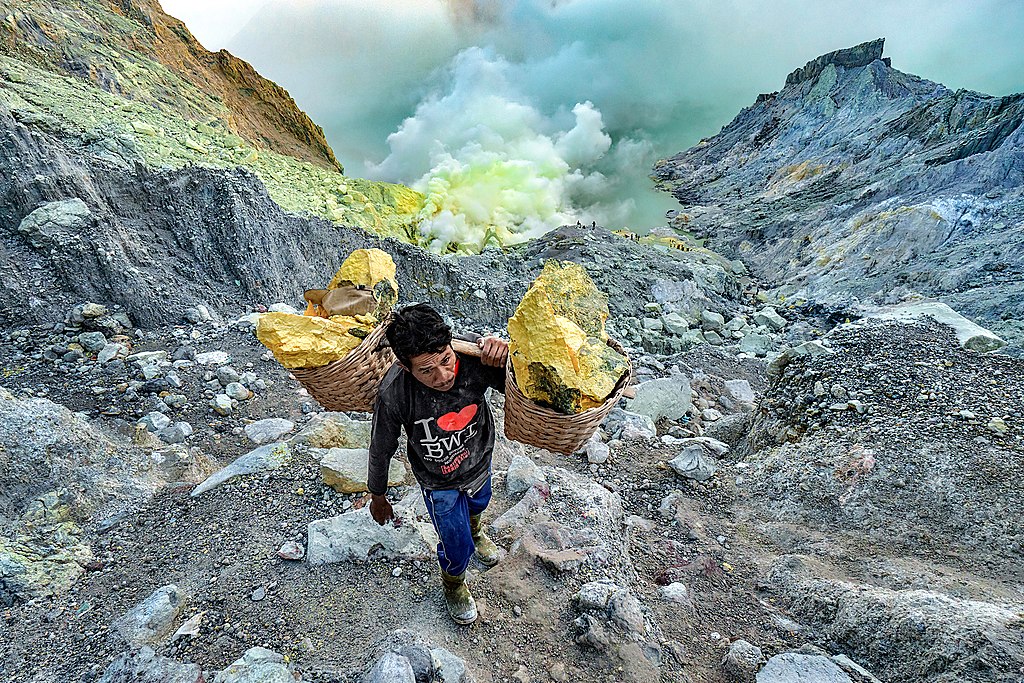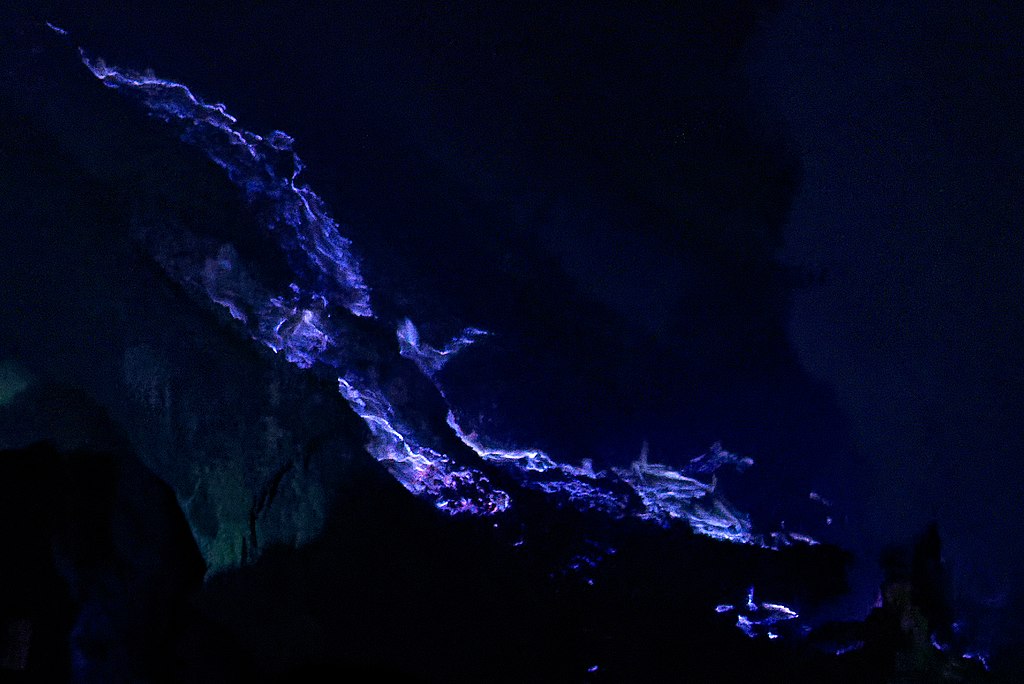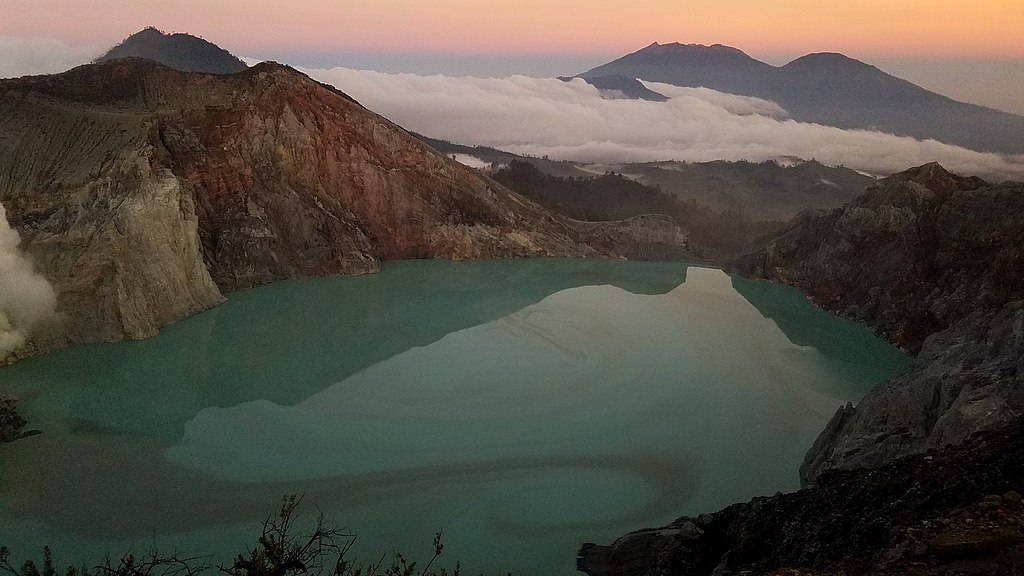From Bali to Mount Ijen
This is Kawah Ijen, culminating at 2799 meters (9084 ft) above sea level and renowned for the turquoise lake that its crater shelters. Driving from Bali to Mount Ijen takes 5 hours 30 minutes including the ferry crossing. You can hike during the day to see the turquoise lake and night to see the famous blue flames. Ijen is listed in UNESCO Global Geopark.
Here, unlike Bromo, no accommodation is available in the immediate vicinity. We advise you to take start in the town of Banyuwangi and find a minibus to drop us off there in the middle of the night to watch the sunrise (more practical details await you at the bottom of the article). The closest accommodations: Banyuwangi (1 hour) or Bondowoso (2 hours).
 Mount Ijen Craters. Ijen Crater is one of the mountains that has a beauty that is very suitable as a photographic object. around the crater there are trees that can add to the beauty of the ijen crater. In Ijen Crater, we can also enjoy the blue fire phenomenon at night where there are only 2 of these phenomena in the world and one of them is here in Ijen and and in Dallol mountain, Ethiopia. HarfiBimantara, CC BY-SA 4.0, via Wikimedia Commons
Mount Ijen Craters. Ijen Crater is one of the mountains that has a beauty that is very suitable as a photographic object. around the crater there are trees that can add to the beauty of the ijen crater. In Ijen Crater, we can also enjoy the blue fire phenomenon at night where there are only 2 of these phenomena in the world and one of them is here in Ijen and and in Dallol mountain, Ethiopia. HarfiBimantara, CC BY-SA 4.0, via Wikimedia Commons
The mount Ijen
Kawah Ijen is a volcano located near Bali, east of Java. The crater of this volcano is filled with an acid lake and its heart is a sulfur deposit.
Mount Ijen, known as “Kawah Ijen” in Indonesian, is an active volcano located in the east of the island of Java. It is located in the middle of a breathtaking landscape of volcanic cones and culminates at 2799 meters (9084 ft). Its crater contains a sulphurous lake of turquoise color, considered the most acidic lake in the world and, at night, you can also observe the famous electric blue flames which emanate (emerge) from the crater.
Many travelers travel to the island of Java, by ferry from the port of Gilimanuk in Bali, to do this must-do hike and then continue their journey with the Mount Bromo trek. Follow our guide to find out everything you need to organize your night hike on Mount Ijen, whether on your own or via an agency, you will be amazed.
What is the time difference between Kawah Ijen and Bali?
Bali is 1h ahead of Kawah Ijen. When 3:50 PM in Kawah Ijen, it’s 4:50 PM in Bali.
What time to start the hiking?
If you want to descend into the crater to see the blue flames, you have to get to the top of the volcano before 3am, so you have to leave the hotel at midnight.
If you don’t want to descend into the crater but just enjoy the sunrise over the lake, you can leave the hotel at 3 a.m. to arrive at dawn, which we did.
Make an appointment with your taxi to pick you up at the desired time from your hotel. Plan a little margin ahead…
How to get to the plateau of Mount Ijen?
The Ijen plateau is accessible by the towns of Bondowoso west of Ijen or by the port of Banyuwangi in the far east of Java, the city where you will disembark if you come to Java by ferry from Bali.
Generally, travelers from West or Central Java head to Probolingo Station which provides several daily trips to Banyuwangi. From Banyuwangi, count 1h30 drive to Mount Ijen. Java is also rather well served by direct buses to Bondowoso, or Banyuwangi from Probolingo bus station.
If you come from Bali by ferry and you come to Java to directly climb Mount Ijen, you can also disembark at the port of Ketapang then go by taxi or car to Bondowoso or Banyuwangi which are not very far from the port.

Kawah Ijen volcano and crater lake, Java, seen from Landsat 8 (American Earth observation satellite launched on February 11, 2013). NASA Earth Observatory image by Jesse Allen, using Landsat data from the U.S. Geological Survey., Public domain, via Wikimedia Commons
Practical information for going from Bali to Mount Ijen by bus
1. Take the local bus to the port of Gilimanuk in West Bali
In Pemuteran, you will need to catch the local bus on the big main road. There are regular ones, ask at the warungs where the stop is. The journey to the Gilimanuk pier is about thirty kilometers. The bus will drop you off in front of the port. Ask for the ferry to Java and buy your ticket at the cash desk (around IDR 35,000 for a return ticket in 2019, i.e. € 2 per crossing). A paper is to be filled in with surname, first name, nationality etc…
2. Arrival at Ketapang port in Java
At the exit of the ferry in Ketapang, I advise you to move away a little from the pier and to negotiate a bemo or a taxi away from the touts. Fix the price beforehand and don’t be fooled, because the drivers very often try to make detours to inflate the price of the race.
How to get from Banyuwangi to Ijen Volcano?
There are 2 options to see the volcano:
Either you book a tour with the hotel with a driver or a minibus that will take you to the volcano for around €80 per person, but you can just as easily organize everything yourself by taking a taxi to bring you to the level from the Paltuding parking area at the foot of the Kawah Ijen volcano.
We advise you to find it in advance, either on the internet or by negotiating a taxi away from the pier. Few Balinese taxis agree to go to Java, for them it’s the end of the world. It is better to find a taxi on Java by paying attention to scams!
Get your transport info here: Bali Airport PickUp, Drop-Off Service, Excursion, Travel and Transportation Services at Villa Carissa
The taxi ride takes about 30 minutes from Banyuwangi. He will leave you at the parking lot and wait for you. Take note of the location of his car, because when you return, there will be a hundred buses and vehicles parked here. The entrance to the path is well indicated and begins after the wooden hut.
Hike during the day to see the turquoise lake
A crazy view of the turquoise lake of the Ijen volcano and the sulfur extraction mine. Moreover, Kawah Ijen means “green crater” in Indonesian. The fumaroles (solfataras) loaded with hydrogen sulfide and sulfur dioxide will react on contact with oxygen and condense into a bright orange liquid sulfur deposit.
The color of Lake Kawah Ijen comes mainly from two parameters. The first is of course due to its extreme acidity. But the acidity does not entirely explain the magnificent hue of this lake. You also have to add a subtle touch of molten metals to the recipe to get the right combination.
 Sunrise over lake in Ijen crater, Jawa, Indonesia. Syselpunk, CC BY-SA 4.0, via Wikimedia Commons
Sunrise over lake in Ijen crater, Jawa, Indonesia. Syselpunk, CC BY-SA 4.0, via Wikimedia Commons
An open pit sulfur mine
Going down to the bottom of the crater, you will be able to see the daily life of the miners who venture to the bottom of the crater every day to collect sulfur with their pickaxe. If you ever get tired during your hike, tell yourself that every day, no less than 300 miners descend and ascend the crater 2 to 3 times a day, carrying up to 80kg (176 lbs) of sulfur per person. They load large blocks of sulfur into their two baskets tied with a wooden stick and placed on their shoulders.
The composition of the lake, as follows:
- 1,300,000 tons of aluminum sulphate
- 600,000 tons of hydrochloric acid
- 550,000 tons of sulfuric acid
- 200,000 tons of alumina
- 170,000 tons of iron sulphate
- 140,000 tons of magnesium sulphate
- 120,000 tons of calcium sulphate
- 100,000 tons of potassium sulphate
- 30,000 tons of 99% pure sulfur
Sulfur is 90% used to prepare sulfuric acid, the basic product of the chemical industry, used to make fertilizers and lead-acid batteries, making car batteries, oil refining, water processing, and mineral extraction. Other applications for sulfur-based chemicals include rubber vulcanization, bleaching paper, and product making such as cement, detergents, and pesticides. And some gunpowder too.

Traditional Sulfur Miners at Kawah Ijen. It is heartbreaking to see the miners making their way up from the bottom of the crater, carrying 80-90 kg of sulfur in baskets on their shoulders. Still the experience is definitely worth it and a must see place. Emjeha, CC BY-SA 4.0, via Wikimedia Commons
Hike at Night to see the blue flames of Mount Ijen
Mount Ijen is best known for its famous blue flames, visible at night. These electric blue flames appear during the combustion of sulfuric gases.
The gases escape from the fissures of the volcano at high pressure and at a temperature of up to 600°C (1112°F). Then, the gases ignite when they come into contact with the air, which creates the famous blue flames which can reach up to 5 meters (6.5 ft) in height.
 Blue fire of Kawah Ijen, East Java, Indonesia. Jakub Hałun, CC BY-SA 4.0, via Wikimedia Commons
Blue fire of Kawah Ijen, East Java, Indonesia. Jakub Hałun, CC BY-SA 4.0, via Wikimedia Commons
These volcanoes that produce blue flames: an unusual case of natural chemiluminescence
At night, the craters of certain volcanoes, such as Dallol in Ethiopia or Kawah Ijen in Indonesia (on the island of Java), offer a grandiose, exceptional and intriguing spectacle: they seem to produce blue lava. In fact, it is the flames above the lava that are azure blue in color.
But where does this blue color come from? It is mainly due to the large amount of sulfur present in the crater. Thus, the sulfur vapors which escape with a temperature of 200°C (392°F) ignite on contact with the air producing blue flames which can sometimes reach up to 5 meters (16.5 ft) in height.
 The blue sulfur flames in the Ijen Caldera. Arie Basuki, CC BY-SA 4.0, via Wikimedia Commons
The blue sulfur flames in the Ijen Caldera. Arie Basuki, CC BY-SA 4.0, via Wikimedia Commons
Descent into the crater to see the blue flames
At this place, we can admire the blue flames, if the conditions allow it (there should not be too much wind). You can wait a few minutes, nothing happens. Then suddenly shows a small formation of blue flames. After 5 minutes, the flame has grown, it’s a real little blue fire that burns!
How to hike to Mount Ijen?
The hike consists of climbing the volcano at night to arrive at the summit an hour before sunrise. Once at the top, while it is still dark, you will descend into the crater to observe the famous blue flames that emerge from it. You will then have to go back up to enjoy a breathtaking view of the crater and the surrounding mountains, and admire the emerald lake at sunrise.
Total hiking time is around 2 hours from Paltuding. The journey continues until you reach the Paltuding Post and you can go to the location by climbing 3 km (1.85 miles) to the edge of the Ijen Crater caldera.
The departure is around 2am from the beginning of the trek. Throughout the ascent, the path is well indicated, wide and without rocks, but the slope is sometimes very steep. You will quickly be out of breath, but since the climb to the summit is no more than 4km, you have plenty of time to take breaks.
The last 30 minutes of the hike (which lasts no more than 2 hours in total) are flat. Finally, the most exhausting part of the hike is the descent to the bottom of the crater, then its ascent before sunrise.

Ijen Volcano at dawn. Ijen Volcano houses the most acidic lake in the world, it is also a source of sulfur, such sulfur creates a chemical reaction that makes the flames in the volcano blue. Jrivera175, CC BY-SA 4.0, via Wikimedia Commons
What to bring for the hike?
- A gas mask to protect you from sulfur fumes that sting the nose and eyes and are dangerous for the lungs!
- A flashlight or headlamp because the hike is done at night.
- Warm clothes: sweaters, gloves, hats. It is very cold at the top of the volcano! And possibly a rain poncho, in case of a downpour…
- Good walking shoes (but no need to buy real trekking shoes)
- Something to eat for breakfast (cereal bar, dried fruit…) and at least 1L of water per person, because there is nothing to buy to drink or eat during the ascent.
- If you want to get to the starting point of the trek on your own, you will need a powerful scooter because the slope is steep.
 The view of Mount Ijen, Banyuwangi, Indonesia. Hildaniar Novitasari, CC BY-SA 4.0, via Wikimedia Commons
The view of Mount Ijen, Banyuwangi, Indonesia. Hildaniar Novitasari, CC BY-SA 4.0, via Wikimedia Commons
Can you climb Mount Ijen without a guide?
Yes ! You can easily climb Mount Ijen without a guide. As explained above, the path is wide and really well indicated. Also, there will be a lot of hikers around you. So you can’t get lost. In reality, the only time the guide can be useful is during the descent and then the ascent of the crater. Indeed, the path to the bottom of the crater is narrow and quite difficult, and can be slippery at times. But go at your own pace and you’ll be fine 🙂
For fares: if you go by yourself to the starting point of the hike from Banyuwangi, count 6,000 IDR for the toll on the road. Then, entrance to Mount Ijen costs IDR 150,000 per person (for tourists) and 10,000 for locals.
Climbing Mount Ijen from Bali with an agency
If you prefer to be taken care of from start to finish, it is possible to go through an agency: Private transport A/R between Bali and Ijen, Ferry crossing, private guide for the ascent.
Ijen Crater Facility
Traveling to Ijen Crater certainly aims to enjoy the natural beauty of Ijen Crater with facilities that are quite complete and in accordance with our tourism needs. Here are some of the facilities in the Ijen Crater tour, including:
- Food stalls
- Toilet
- Parking location
- Mask rental
- Tour guide
- Local taxi
- Sunrise view point
- Blue fire view pont
- Souvenirs
Photo credit (main picture): Ardhanragil (CC BY-SA 4.0) via Wikimedia Commons
Must See Places in Indonesia | A Guide to the Country’s Best Attractions to Explore and Discover
Have you booked your villa in Seminyak center (South Bali)?
Located in Seminyak Center – Bali, Villa Carissa offers a private swimming pool and enclosed garden to guarantee your privacy. You can book your private pool villa here with us.
